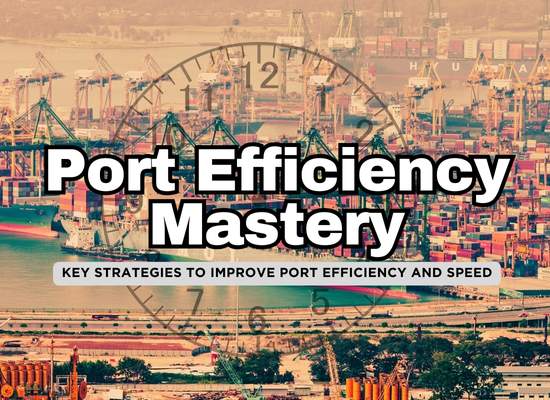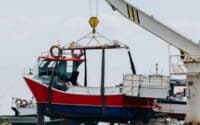Port Turnaround Time: Improving Speed and Success

Delays at ports not only cost shipowners millions in demurrage fees but also waste fuel through prolonged idle time and disrupt critical shipping schedules. In today’s dynamic trade environment, optimizing turnaround times has become a top priority for stakeholders—port authorities, shipping lines, and logistics managers alike. By embracing advanced technologies, enhancing coordination, and refining operational processes, ports can slash delays, boost cargo throughput, and maintain a competitive edge in global trade. Let’s explore the key strategies and innovative solutions that ports and shipping lines can implement to minimize delays, improve turnaround times, and stay ahead in the ever-evolving global trade landscape.
🧮 Article Contains ShipUniverse Maritime Calculators

** We welcome your feedback, suggestions, corrections, and ideas for enhancements. Please email editor at shipuniverse.com **
1️⃣ Maximizing Efficiency: Understanding and Measuring Port Turnaround Time 📏
Port turnaround time refers to the total time a vessel spends in port, from the moment it arrives at the anchorage or berth to the moment it departs. This includes several key phases:
- Docking Time – Time spent getting into position at the berth.
- Cargo Handling – Loading and unloading cargo operations.
- Customs and Inspections – Clearance of cargo by customs authorities.
- Departure Time – The time needed to prepare and leave port.
Turnaround time directly impacts shipping schedules, costs, and cargo delivery reliability. Reduced turnaround time leads to faster voyages, better fleet utilization, and minimized operational disruptions, giving both ports and shipping lines a competitive advantage.
🔍 How to Measure and Track Efficiency
Ports and shipping companies rely on metrics like berth productivity (TEUs/hour) and average port stay time to gauge performance. The ideal approach involves continuous monitoring of these data points through Port Community Systems (PCS) or Terminal Operating Systems (TOS), which provide real-time visibility.
- Example Formula:
Turnaround Time (Total Hours) = Docking + Cargo Handling + Customs + Departure - Current Trend: Many advanced ports (e.g., Singapore, Rotterdam) have reduced their average turnaround time to under 24 hours for container vessels through automation and better planning.
| ShipUniverse: Port Turnaround Time Calculator | |
|---|---|
| Docking Time (hours) | |
| Cargo Handling Time (hours) | |
| Customs Clearance Time (hours) | |
| Departure Preparation Time (hours) | |
| Target Turnaround Time (hours) | |
| Demurrage Cost (per hour in USD) | |
| Select Improvement Area | |
| Total Turnaround Time: -- hours | |
| Time Reduction Needed: -- hours | |
| Estimated Savings: -- USD | |
Key Metrics for Measuring Turnaround Time Efficiency
Tracking performance metrics helps ports identify bottlenecks and areas for improvement. Here are some key metrics used by high-performing ports to evaluate and enhance turnaround efficiency:
- Berth Productivity
- Measured in moves per hour (e.g., TEUs/hour), it indicates how efficiently cargo is loaded/unloaded at a berth.
- Top ports like Singapore achieve productivity rates of 35+ container moves per hour per crane.
- Port Stay Time
- This is the total time a vessel spends at a port, from arrival to departure.
- Ports aiming to compete globally aim for less than 24 hours for container ships.
- Quay Crane Utilization
- The percentage of crane capacity used during cargo handling. Efficient ports maximize crane availability to reduce idle time.
- Customs Clearance Time
- Delays at this stage can significantly increase turnaround time.
- Digital customs platforms and pre-arrival clearance can reduce processing time by 30-50%.
Common Issues Affecting Turnaround Time
Even the most advanced ports face challenges that can delay operations. Key issues include:
- Port Congestion: A backlog of vessels waiting for berths can extend waiting times by hours or days.
- Inconsistent Cargo Flow: Delays in inland transportation or storage mismanagement can disrupt loading and unloading schedules.
- Labor Shortages: Insufficient staffing, especially during peak seasons, can slow down cargo operations.
Trends and Developments
Ports worldwide are investing in automation, real-time tracking systems, and data integration platforms to improve turnaround performance. For example, smart ports like Rotterdam are leveraging AI-driven analytics to optimize docking schedules and cargo flow, reducing delays by up to 20%. Digital collaboration between shipping lines and port authorities has also become a critical success factor in achieving faster turnaround times.
2️⃣ Eliminate Delays: Key Factors That Impact a Port's Performance ⏱️
Delays at ports lead to increased costs, schedule disruptions, and missed opportunities. Understanding the factors that influence port performance is essential for reducing turnaround time. Here are the key factors explained in detail:
1. Port Congestion
Congestion occurs when multiple vessels arrive at once, creating a backlog.
- Impact: Ships may wait hours or even days for a berth, affecting shipping schedules and disrupting supply chains.
- Solution: Implement vessel scheduling and berth allocation systems. Expanding terminal capacity can also help alleviate congestion.
2. Cargo Handling Speed and Equipment Efficiency
The pace of loading and unloading cargo depends on equipment performance and availability.
- Impact: Inefficient equipment or poor operations reduce crane productivity, extending port stay times.
- Solution: Invest in automated container handling systems and ensure regular maintenance. Staff training also boosts efficiency.
3. Customs and Documentation Processes
Customs clearance and cargo documentation can be bottlenecks if processes are outdated or poorly managed.
- Impact: Lengthy customs inspections or incomplete paperwork can cause major delays, even after cargo is loaded.
- Solution: Use digital customs platforms, enable pre-clearance procedures, and improve coordination between customs authorities and port operators.
4. Berth Availability and Allocation
Limited berths can result in long vessel queues, particularly at busy ports.
- Impact: Delays in berth availability lead to idle vessels waiting offshore, increasing costs.
- Solution: Implement dynamic berth allocation software and expand docking infrastructure to handle more traffic.
5. Inland Transport Bottlenecks
Delays in moving cargo from the port to its destination can create bottlenecks.
- Impact: Terminal congestion increases when trucks or trains are not available to clear cargo quickly.
- Solution: Improve coordination with inland transportation services and upgrade port access routes.
6. Labor and Staffing Issues
Inadequate staffing or inefficient labor shifts during high-demand periods can slow operations.
- Impact: Reduced productivity leads to cargo backlogs, increasing the overall turnaround time.
- Solution: Implement flexible shift schedules, train staff to improve productivity, and ensure sufficient labor availability during peak seasons.
7. Weather and Environmental Factors
Adverse weather conditions, such as storms, high winds, or fog, can halt port operations.
- Impact: Docking, loading, and unloading are delayed until conditions improve, disrupting shipping schedules.
- Solution: Use weather forecasting tools to plan operations. Implement contingency measures for severe weather.
8. Cargo Imbalance and Storage Constraints
An imbalance between incoming and outgoing cargo, or insufficient storage space, can create inefficiencies.
- Impact: Excess cargo clogs terminal operations, leading to delays in handling new shipments.
- Solution: Optimize container flow management and invest in scalable storage facilities to handle cargo fluctuations.
9. Communication and Coordination Failures
Poor communication between port operators, shipping companies, and logistics providers can lead to inefficiencies.
- Impact: Lack of real-time updates causes delays in scheduling, cargo readiness, and documentation processing.
- Solution: Implement Port Community Systems (PCS) to facilitate real-time data sharing and coordination across stakeholders.
10. Regulatory and Compliance Delays
Ports often face delays due to regulatory inspections and compliance checks.
- Impact: Extended inspection times and unclear regulations slow down cargo clearance and vessel operations.
- Solution: Improve transparency and efficiency in regulatory processes through digital solutions and ongoing collaboration with authorities.
| ShipUniverse: Delay Impact Calculator | ||
|---|---|---|
| Delay Cause | Duration (hours) | Throughput Impact (%) |
| Port Congestion | ||
| Cargo Handling | ||
| Customs/Documentation | ||
| Labor/Staffing | ||
| Weather Conditions | ||
| Total Delay Time: -- hours | ||
| Overall Throughput Reduction: -- % | ||
3️⃣ Speed Up Turnaround: Operational Strategies for Ports 🚀
Port turnaround time is a critical performance indicator for both port operators and shipping lines. Reducing turnaround time improves profitability, fleet utilization, and overall supply chain efficiency. Implementing strategic changes can dramatically enhance port operations and minimize costly delays. Here are the top operational strategies ports can adopt to speed up turnaround.
✔️ Optimize Berth and Vessel Scheduling
Poor scheduling leads to overlapping vessel arrivals, creating congestion and delays. Efficient scheduling ensures smoother traffic flow.
- How to Improve:
- Implement dynamic berth allocation systems to optimize berth usage in real-time.
- Use predictive analytics to forecast peak periods and pre-allocate resources.
- Collaborate with shipping companies to schedule vessels with minimal overlap.
- Tech Example: Ports like Rotterdam use digital platforms to provide real-time scheduling and berth updates to vessels.
✔️ Invest in Advanced Cargo Handling Systems
Loading and unloading cargo quickly is one of the biggest drivers of turnaround efficiency. Outdated or underperforming equipment slows down the entire process.
- How to Improve:
- Upgrade to automated or semi-automated cranes and equipment for faster container movements.
- Increase the number of operational cranes during peak hours.
- Implement terminal automation for efficient resource allocation.
- Impact: Advanced cranes can increase productivity to over 35 container moves per hour, compared to manual operations averaging 15-20 moves per hour.
✔️ Streamline Customs and Regulatory Processes
Customs clearance is often a major bottleneck in ports, causing cargo to sit idle while awaiting inspections.
- How to Improve:
- Introduce electronic customs platforms to enable digital documentation and pre-clearance.
- Coordinate with customs authorities to conduct parallel inspections for multiple shipments.
- Use data-sharing agreements to reduce redundant checks across customs offices and regulatory agencies.
- Success Insight: Ports with streamlined customs processes have reduced inspection times by up to 30% through digitalization.
✔️ Expand Port Infrastructure and Capacity
Ports with limited berths, cranes, and storage facilities struggle to accommodate growing cargo volumes, leading to congestion and delays.
- How to Improve:
- Expand berth capacity to accommodate more vessels during peak periods.
- Invest in additional storage yards to handle overflow cargo.
- Optimize port layout to reduce distances between docking areas, storage, and transportation hubs.
- Impact: Expanding capacity reduces vessel waiting times and increases the port’s throughput potential.
✔️ Implement Real-Time Data and Port Community Systems (PCS)
Lack of coordination between stakeholders such as port operators, customs, and shipping lines leads to inefficiencies. Real-time data sharing improves decision-making and reduces delays.
- How to Improve:
- Adopt a Port Community System (PCS) to integrate real-time data from all stakeholders (vessels, terminals, customs, logistics providers).
- Use IoT devices to track cargo movements and equipment performance.
- Implement digital dashboards that provide operational visibility and predictive insights.
- Example: Ports using PCS have reduced communication delays by up to 40%, improving overall scheduling and cargo flow.
✔️ Enhance Labor Management and Training
Labor productivity is critical during peak periods. Poorly managed shifts and insufficient staffing lead to bottlenecks.
- How to Improve:
- Implement flexible shift schedules to meet peak demand.
- Regularly train workers to improve equipment handling and safety procedures.
- Monitor performance data to optimize staffing levels.
- Impact: Ports with well-managed labor systems report faster handling times and fewer safety-related stoppages.
✔️ Improve Inland Transportation Coordination
Delays in transporting cargo to and from the port (by truck or rail) can cause terminal congestion, preventing smooth cargo flow.
- How to Improve:
- Increase collaboration with trucking and rail providers to align schedules with port operations.
- Implement digital tracking systems to monitor cargo movement and prevent bottlenecks.
- Impact: Efficient inland coordination minimizes cargo dwell times and accelerates container turnover.
✔️ Implement Predictive Maintenance for Equipment
Equipment breakdowns (e.g., cranes, forklifts) can bring cargo handling to a halt, causing significant delays.
- How to Improve:
- Use IoT sensors and data analytics to monitor the condition of critical equipment.
- Schedule maintenance based on usage and real-time performance data rather than on fixed intervals.
- Impact: Predictive maintenance reduces unplanned downtime, keeping operations running smoothly and minimizing costly delays.
✔️ Increase Stakeholder Engagement and Collaboration
Delays often arise from a lack of alignment between stakeholders (e.g., customs, logistics providers, shipping lines).
- How to Improve:
- Regularly host coordination meetings with all stakeholders to streamline procedures.
- Establish shared KPIs (Key Performance Indicators) to promote accountability and efficiency.
- Impact: Improved collaboration reduces friction points across operations, ensuring smoother vessel and cargo handling.
4️⃣ Speed Up Turnaround: Steps Ships Can Take to Minimize Port Time ⏩
Ships play a crucial role in minimizing port turnaround time. By preparing in advance and maintaining efficient onboard operations, vessels can reduce delays, avoid penalties, and improve voyage profitability. Here are actionable strategies that ships can adopt to speed up turnaround and optimize their time in port.
✔️ Complete Documentation and Clearance in Advance
Missing or incomplete paperwork can lead to customs and regulatory delays, preventing cargo handling from starting on time.
- Steps to Take:
- Submit all necessary documentation (customs declarations, manifests, bills of lading) electronically before arriving at the port.
- Coordinate with the port authority to ensure pre-clearance procedures are in place.
- Impact: Ships that handle documentation in advance can reduce customs delays by 30-50%, ensuring faster cargo processing.
✔️ Optimize Cargo Stowage Planning
Poorly planned cargo stowage increases the time required for loading and unloading, causing delays at the terminal.
- Steps to Take:
- Use advanced stowage software to optimize container placement for efficient unloading.
- Collaborate with the terminal to prioritize critical cargo (e.g., time-sensitive goods).
- Impact: Efficient stowage planning can reduce cargo handling time by 15-20%, especially for containerized cargo.
✔️ Ensure Crew and Equipment Readiness
Delays in cargo handling often result from unprepared crew or malfunctioning onboard equipment such as cranes, winches, or ramps.
- Steps to Take:
- Conduct pre-arrival inspections of all cargo-handling equipment.
- Train crew members on efficient coordination with terminal staff.
- Impact: A fully prepared crew and equipment can minimize downtime, improving handling efficiency by up to 20%.
✔️ Improve Communication with the Port Authority
Poor communication between the ship and port can lead to missed berthing windows and operational delays.
- Steps to Take:
- Maintain real-time communication with port control regarding ETA updates, cargo requirements, and berthing instructions.
- Use automated communication systems to reduce errors and delays.
- Impact: Improved communication can reduce waiting times for berthing and docking by 10-15%.
✔️ Streamline Bunkering, Maintenance, and Other Port Services
Ships often perform multiple activities in port (e.g., refueling, maintenance, crew changes) that can extend port stay time.
- Steps to Take:
- Schedule critical services like bunkering and maintenance to run concurrently with cargo operations.
- Coordinate service providers in advance to prevent scheduling conflicts.
- Impact: Efficient scheduling of port services can shorten overall port stay by 2-4 hours on average.
✔️ Monitor and Adapt to Port-Specific Procedures
Each port may have unique operational rules and requirements that can affect turnaround time.
- Steps to Take:
- Research port-specific guidelines on arrival procedures, berthing, and cargo handling.
- Collaborate with the port agent to understand and comply with local requirements.
- Impact: Being prepared for port-specific procedures can prevent unnecessary delays and penalties, keeping operations on schedule.
5️⃣ Collaborate and Innovate: Leveraging Technology and Coordination for Faster Turnarounds 🤝
In today’s competitive shipping environment, ports and shipping lines must work together to reduce turnaround times. By embracing technology, improving stakeholder coordination, and fostering innovation, ports can enhance efficiency and minimize costly delays. This section outlines how collaboration and technology can revolutionize port operations, improve cargo flow, and boost profitability.
🟢 Adopt Port Community Systems (PCS)
Disjointed communication between shipping lines, terminal operators, customs authorities, and inland transport providers causes delays at every stage of port operations.
- A Port Community System (PCS) integrates data and communication between stakeholders in real-time.
- Information such as berth schedules, customs clearance, and cargo status is shared instantly, improving decision-making and reducing miscommunication.
- Example: The Port of Rotterdam's PCS reduced communication delays by 40%, significantly improving cargo throughput.
🟢 Embrace Internet of Things (IoT) and Predictive Analytics
Equipment failures and unexpected operational issues often lead to unplanned downtime. Predictive analytics and IoT sensors help ports anticipate problems before they occur.
- IoT sensors monitor equipment performance in real-time, collecting data on usage, wear, and maintenance needs.
- Predictive algorithms identify potential failures, allowing ports to conduct maintenance proactively rather than reactively.
- Impact: Ports implementing IoT-based predictive maintenance, like Hamburg, have reduced downtime by 30%, ensuring smoother operations.
🟢 Implement Automated Systems and Robotics
Automated cargo handling reduces the time and labor required for loading and unloading. This improves productivity, especially during peak traffic.
- Automated cranes and container stacking systems handle cargo with minimal human intervention.
- Robotics streamline repetitive tasks, such as sorting and transporting containers within terminals.
- Example: The Port of Los Angeles deployed automated cranes, increasing productivity by over 35 container moves per hour compared to 15-20 moves with manual operations.
🟢 Use Digital Twin Technology for Port Operations
Ports are complex environments with many moving parts. Digital twin technology creates a virtual model of port operations, enabling simulation and optimization of workflows.
- The digital twin mirrors real-time data from port operations, providing a platform to simulate various scenarios (e.g., congestion management, berth scheduling).
- Port operators can test different strategies and predict outcomes before making changes.
- Impact: Ports using digital twins can optimize traffic flow and reduce inefficiencies, leading to faster turnarounds.
🟢 Strengthen Stakeholder Collaboration
Turnaround delays often result from poor coordination among stakeholders, including shipping companies, port operators, customs, and logistics providers.
- Establish regular communication channels and coordination meetings to align schedules and procedures.
- Use shared KPIs (Key Performance Indicators) to monitor and improve efficiency collectively.
- Example: Singapore's port authorities hold monthly coordination meetings with stakeholders, leading to more streamlined operations and reduced berth waiting times.
🟢 Enable Real-Time Tracking and Transparency
A lack of visibility into cargo movement and operational status can create bottlenecks and inefficiencies.
- Implement real-time tracking systems that provide continuous updates on vessel location, cargo handling status, and customs progress.
- Share this data with stakeholders through digital dashboards.
- Impact: Ports that improve visibility through real-time tracking, like Antwerp, have seen a 15-20% improvement in turnaround time efficiency.
🟢 Leverage AI and Machine Learning for Optimization
AI algorithms can analyze vast amounts of operational data to identify bottlenecks and recommend improvements.
- AI-powered systems optimize berth allocation, crane usage, and cargo flow based on predictive demand models.
- Machine learning adapts to historical data, continuously improving efficiency recommendations.
- Impact: AI systems have helped ports reduce berthing delays by 10-15%, particularly during high-demand periods.
🟢 Coordinate Multi-Modal Transport Systems
Efficient coordination between ports, rail, and trucking systems ensures that cargo moves quickly out of terminals, preventing congestion.
- Establish real-time links between port terminals and inland transport providers for better synchronization of schedules.
- Optimize rail and truck dispatching based on terminal loading times and cargo readiness.
- Example: The Port of Los Angeles improved cargo clearance times by 40% by enhancing coordination with rail and trucking providers.
🟢 Promote Innovation and Continuous Improvement
The maritime industry is constantly evolving, and ports must innovate to stay competitive.
- Encourage innovation through partnerships with technology providers and research institutions.
- Implement continuous improvement programs that regularly evaluate and refine port operations.
- Example: Ports participating in innovation hubs (e.g., Rotterdam’s PortXL) have accelerated technology adoption, leading to sustained performance gains.
By combining technology-driven innovation and collaboration across stakeholders, ports can achieve faster turnaround times, lower costs, and higher throughput. These strategies not only improve port competitiveness but also ensure smoother operations across the entire global supply chain.
| ShipUniverse: Technology ROI Calculator | |
|---|---|
| Technology Investment (USD) | |
| Efficiency Gain (%) | |
| Current Operational Cost (USD per year) | |
| Annual Maintenance Cost (USD) | |
| Payback Period: -- years | |
| Annual Savings: -- USD | |
| Total 5-Year ROI: -- USD | |
Table Summary
| ShipUniverse: Maximize Efficiency - Understanding Port Turnaround Time | ||
| Key Area | Description | Benefit |
| What is Port Turnaround Time? | The time from when a ship arrives at port to when it departs. It includes docking, cargo handling, and clearance. | Understanding this helps ports and ships reduce operational delays and costs. |
| Why It Matters | Efficient turnaround time improves fleet utilization, reduces demurrage costs, and enhances port capacity. | Increased profitability and operational efficiency for both ports and shipping lines. |
| Key Metrics to Monitor | Berth waiting time, cargo handling time, customs clearance time, and departure preparation time. | Identifying bottlenecks allows stakeholders to focus on targeted improvements. |
| Tracking Tools | Digital dashboards, IoT sensors, and real-time data-sharing platforms help track operational performance. | Improved visibility into operations, enabling faster decision-making and proactive planning. |
| Real-World Impact | Ports using technology-driven efficiency improvements have reduced turnaround time by up to 30%. | Higher throughput, reduced congestion, and better service reliability. |
| ShipUniverse: Eliminate Delays - Key Factors That Impact Port Performance | ||
| Factor | Description | Impact/Benefit |
| Port Congestion | Occurs when multiple vessels arrive at the same time, creating a backlog for berthing and cargo operations. | Leads to longer wait times for ships, increased costs, and operational inefficiencies. |
| Berth Availability | Limited berth space causes vessels to queue up for docking, delaying cargo operations. | Dynamic berth allocation reduces wait times and increases port throughput. |
| Cargo Handling Speed | Inefficient or outdated equipment slows down loading and unloading operations. | Investing in automation boosts productivity, enabling faster cargo handling. |
| Customs and Regulatory Processes | Time-consuming inspections and paperwork can cause significant delays. | Digital customs clearance reduces processing times, improving cargo flow by up to 30%. |
| Labor and Staffing Issues | Poorly managed shifts and insufficient staffing during peak periods lead to delays. | Optimized labor scheduling improves productivity and reduces operational bottlenecks. |
| Weather Conditions | Adverse weather such as storms or fog can halt operations temporarily. | Predictive weather tools and contingency planning minimize disruptions. |
| ShipUniverse: Speed Up Turnaround - Operational Strategies for Ports | ||
| Strategy | Description | Benefit |
| Optimize Berth Scheduling | Use real-time berth allocation systems and predictive analytics to minimize vessel overlap and waiting times. | Reduces vessel queues, improving overall port efficiency and cargo flow. |
| Invest in Advanced Cargo Handling | Upgrade cranes and automated cargo systems to speed up loading and unloading operations. | Boosts container moves per hour, reducing time ships spend at port. |
| Expand Infrastructure and Capacity | Add berths, storage areas, and transport connections to handle increased cargo volumes. | Minimizes congestion and increases port throughput capacity. |
| Implement Port Community Systems (PCS) | Integrate real-time communication and data-sharing between port operators, customs, and shipping lines. | Enhances coordination and reduces delays caused by miscommunication. |
| Use Predictive Maintenance | Monitor equipment with IoT sensors and schedule maintenance before breakdowns occur. | Reduces unplanned downtime and keeps operations running smoothly. |
| Enhance Labor Management | Optimize shift schedules and provide regular training to improve workforce productivity. | Increases operational efficiency during peak periods and reduces delays. |
| ShipUniverse: Speed Up Turnaround - Steps Ships Can Take | ||
| Step | Description | Benefit |
| Complete Documentation in Advance | Submit all required customs and cargo paperwork before arriving at the port to avoid clearance delays. | Reduces customs delays, allowing for faster cargo handling. |
| Optimize Cargo Stowage Planning | Use advanced stowage software to arrange containers for quick unloading based on cargo priority. | Shortens unloading times by improving cargo accessibility. |
| Ensure Crew and Equipment Readiness | Conduct pre-arrival inspections of cargo-handling equipment and train crew for efficient port operations. | Minimizes delays caused by equipment malfunctions or unprepared crew. |
| Maintain Real-Time Communication | Keep in contact with port control to receive updates on berthing schedules and operational changes. | Prevents missed berthing windows and reduces wait times. |
| Coordinate Port Services Efficiently | Schedule services like bunkering, maintenance, and crew changes to run parallel with cargo operations. | Reduces the overall time spent at port by consolidating tasks. |
| Adapt to Port-Specific Procedures | Research and follow the unique rules and requirements of each port to ensure compliance and smooth operations. | Avoids unexpected delays or penalties caused by procedural misunderstandings. |
| ShipUniverse: Collaborate and Innovate - Leveraging Technology and Coordination | ||
| Technology/Strategy | Description | Benefit |
| Port Community Systems (PCS) | Integrate data and communication among shipping lines, customs, and terminal operators for real-time updates. | Improves coordination, reduces delays by up to 40%, and accelerates cargo flow. |
| IoT and Predictive Maintenance | Monitor equipment performance with IoT sensors and schedule proactive maintenance to prevent breakdowns. | Reduces unplanned downtime and equipment-related delays. |
| Automation and Robotics | Deploy automated cranes and robots to speed up container handling and minimize human error. | Increases productivity, reducing loading/unloading times significantly. |
| Digital Twin Technology | Create a real-time virtual model of port operations to simulate and optimize workflows. | Allows for proactive planning and optimization, reducing inefficiencies. |
| Stakeholder Collaboration | Establish shared KPIs and regular communication between stakeholders such as customs, port operators, and shipping lines. | Aligns efforts, reduces friction, and improves overall port performance. |
| Real-Time Tracking and Transparency | Implement systems that provide continuous updates on vessel location, cargo status, and port services. | Enhances visibility, enabling faster decision-making and reduced delays. |

Do you have a Maritime Product or Service that may be of interest to Shipowners? Tell us about it here!
Do you have feedback or insights? Please reach out to editor @ shipuniverse.com



